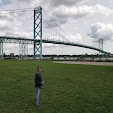Located a few hundred feet downriver from the Old Vicksburg
Bridge, the Vicksburg Bridge, or the “New” Bridge, serves as the city’s vehicular
crossing of the Mississippi River on the main highway connecting Vicksburg with
northeastern Louisiana to the west and the state capital of Jackson to the
east.
The completion of the original Vicksburg Bridge in 1930 was
seen as a huge success and the bridge proved to be a profitable entity for both
road and railroad interests along the path of the Dixie Overland Highway and
the subsequent US Highway 80 corridor. In the years after the creation of the
National Interstate Highway System, planning commenced on a new bridge at the
site that would relieve the congestion on the existing bridge while providing
for a more modern crossing of the river that would be safe for all vehicles. The
construction of the new bridge at Vicksburg was completed in 1973 and its
design intentionally mimics that of its predecessor nearby. This was due in large
part to the realities of the Mississippi River at this location. Due to the occasional
presence of eddies and crosscurrents in the river in this area, it was realized
during the planning of the bridge that the new structure needed to be placed
parallel to the existing bridge with its piers also located in line with the
existing structure so that barges and river traffic would not have to zig-zag
or alter course while trying to pass beneath both bridges. As a result of the constraints
of where the new bridge’s piers could be located, designers chose to
essentially replicate the proportions and appearance of the old bridge, while
building a wider roadway with modern-width travel lanes.

This view of the two monstrous steel bridges on the Mississippi River at Vicksburg is available to visitors to the Mississippi Welcome Center located off of Exit 1A on Interstate 20. The Old Vicksburg Bridge is to the right, while the "new" Vicksburg Bridge is to the left.
Like its older neighbor just upriver, this new bridge is a
lengthy steel truss bridge with multiple deck truss spans on each side of the
main span. The longest span of the bridge is 870 ft and it has an overall
length of about 2 ½ miles from abutment to abutment, due to a lengthy approach
viaduct on the Louisiana side of the river that enables the roadway to span the
river floodplain and levee to the west.
Built for high-speed traffic, this bridge has been part of
Interstate 20 since its opening in 1973. I-20 is one of the major east-west freeway corridors
for the American Deep South, stretching from western Texas to eastern South
Carolina by way of Dallas, Shreveport, Jackson, Birmingham, and Atlanta. In
1998, the US Highway 80 designation was relocated to this bridge upon the
closure of the Old Vicksburg Bridge to vehicle traffic. As it stands, the
Vicksburg Bridge is the busiest bridge on the lower Mississippi River between
Memphis and Baton Rouge and it serves a mix of local and long-distance traffic
along one of America’s busiest interstate highway corridors.
Further Reading:
Vicksburg Bridge by John Weeks
Vicksburg Bridge at historicbridges.org
Vicksburg's Mississippi River Bridges by Gribblenation
Bridges, Crossings, and Structures of the Lower Mississippi River
Next Crossing upriver: Old Vicksburg Bridge (Vicksburg, MS)
Next Crossing downriver: Natchez-Vidalia Bridge (Natchez, MS)
Visit the Mississippi River Bridges of Vicksburg Overview Page
Return to the Bridges of the Lower Mississippi River Home Page
__________________________________________________

































































































Comments